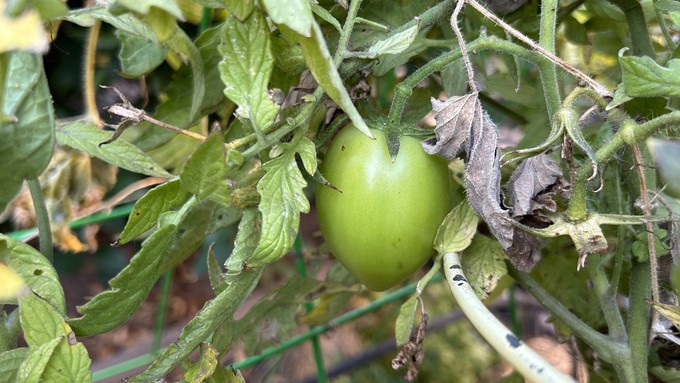
Fall weather (including some rain) arrives as we 'fall back' to standard time; remember to reset your clocks

This Roman Warrior tomato very likely won't get a chance to turn red outside. High temperatures are dropping this next week into the 60s. Best to pick the remaining green tomatoes and let them ripen indoors. Kathy Morrison
As we prepare to “fall back,” our weather is definitely turning towards autumn with cooler temperatures and some definite rain.
According to the National Weather Service, Northern California can expect to get wet in the next few days. But how much rain?
“Another round of showers is forecasted next week beginning on Monday,” tweeted the NWS Sacramento office. “Higher rainfall totals are expected north of I-80 and in higher elevations. You can check your local forecast by visiting http://weather.gov/sto and typing in your city or zip code!”
Clouds will start rolling in on Sunday along with a big drop in temperatures. After summery days in the 80s, Sacramento’s forecast high on Sunday is only 71 degrees – and it gets cooler from there. The weather service predicts highs in the low to mid 60s all next week.
As of Saturday morning, Sacramento can expect 0.1 to 0.25 inches from this storm – not enough to turn off the irrigation, but it’s a start.
More rain is on the way, too. A second light storm is expected to arrive Friday – just in time to dampen next weekend.
Make the most of moist soil; finish planting your cool-season garden.
And don’t forget to turn back your clocks before you go to bed Saturday night; standard time returns Sunday. “Enjoy the extra hour of sleep,” says the weather service. “You’ve earned it with the darker mornings and evenings.”
* This damp, cool weather likely will finish off the last of the tomatoes. Pick the green tomatoes to ripen indoors and pull the vines.
* Pull other faded annuals and vegetables.
* Prune dead or broken branches from trees.
* Plant bulbs for spring bloom. Some possible suggestions: daffodils, crocuses, hyacinths, tulips, anemones and scillas.
* This is also a good time to seed wildflowers.
* Now is the best time to plant most trees and shrubs. This gives them plenty of time for root development before spring growth. They also benefit from fall and winter rains.
* Lettuce, cabbage and broccoli also can be planted now.
* Plant garlic and onions.
* Now is the time to plant seeds for many flowers directly into the garden, including cornflower, nasturtium, nigella, poppy, portulaca, sweet pea, sweet alyssum, bachelor buttons and stock.
* Plant seeds for radishes, bok choy, mustard, spinach and peas.
* Set out cool-weather bedding plants, including calendula, pansy, snapdragon, primrose and viola.
* Reseed and feed the lawn. Work on bare spots.
Comments
0 comments have been posted.Sacramento Digs Gardening to your inbox.
Food in My Back Yard Series
April 29: What's (already) wrong with my tomato plants?
April 22: Should you stock up on fertilizer? (Yes!)
April 15: Grow culinary herbs in containers
April 8: When to plant summer vegetables
April 1: Don't be fooled by these garden myths
March 25: Fertilizer tips: How to 'feed' your vegetables for healthy growth
March 18: Time to give vegetable seedlings some more space
March 11: Ways to win the fight against weeds
March 4: Potatoes from the garden
Feb. 25: Plant a fruit tree now -- for later
Feb. 18: How to squeeze more food into less space
Feb. 11: When to plant? Consider staggering your transplants
Feb. 4: Starting in seed starting
Sites We Like
Garden Checklist for week of May 4
Enjoy this spring weather – and get gardening!
* Plant, plant, plant! It’s prime planting season in the Sacramento area. Time to set out those tomato transplants along with peppers and eggplants. Pinch off any flowers on new transplants to make them concentrate on establishing roots instead of setting premature fruit.
* Direct-seed melons, cucumbers, summer squash, corn, radishes, pumpkins and annual herbs such as basil.
* Harvest cabbage, lettuce, peas and green onions.
* In the flower garden, direct-seed sunflowers, cosmos, salvia, zinnias, marigolds, celosia and asters. (You also can transplant seedlings for many of the same flowers.)
* Plant dahlia tubers. Other perennials to set out include verbena, coreopsis, coneflower and astilbe.
* Transplant petunias, marigolds and perennial flowers such as astilbe, columbine, coneflowers, coreopsis, dahlias, rudbeckia and verbena.
* Keep an eye out for slugs, snails, earwigs and aphids that want to dine on tender new growth.
* Feed summer bloomers with a balanced fertilizer.
* For continued bloom, cut off spent flowers on roses as well as other flowering plants.
* Add mulch to the garden to maintain moisture. Mulch also cuts down on weeds. But don’t let it mound around the stems or trunks of trees or shrubs. Leave about a 6-inch to 1-foot circle to avoid crown rot or other problems.